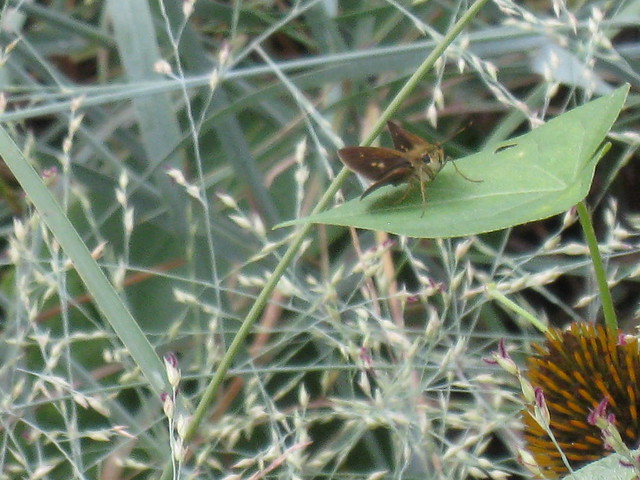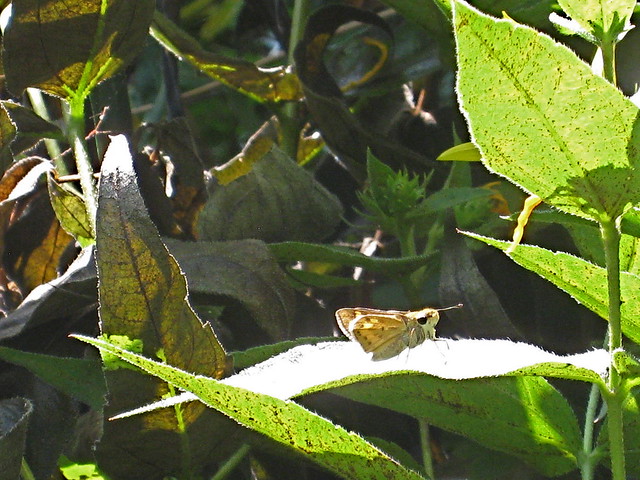 |
| Northern Broken-Dash Skipper? AMcC |
I had planned to do a third post on Silphiums, but there are too many butterflies in the garden for that! It’s all the more exciting since this summer has not been the best for butterflies. I don’t know if it’s been the weather, my garden, or the truck that sprayed mosquitoes (and every other living thing) on my street in late June. Whatever the problem, butterfly numbers seem to be recovering. Skippers are everywhere.
Skippers are small, fast-flying butterflies. Compared to the wings, the head is large—kind of cute if you get to see it well. Most are golden-brown or brown and frustrating to identify. It’s been said that skippers are the Empidonax of the butterfly world. (That last sentence actually means something to birders.) If you’re going to have any chance at all identifying skippers, you’ll need a good butterfly book with range maps and a close focusing set of binoculars. See my list of “Favorite Nature and Gardening Books” below. Having a digital camera and an expert friend to study the photo are probably required for some skippers.
I’ve had a new species in the yard this week that I tentatively identified as Northern Broken-Dash Skipper. I sent a photo to my friend Yvonne to see what she thinks. Northern Broken-Dash and Little Glassywing are very similar and my yard is within the range of both. The larvae of both eat grass. According to Glassberg’s Butterflies through Binoculars: The East, Little Glassywing’s caterpillars eat purpletop grass. I don’t have any purpletop in my yard, but it is common and probably can be found 1/2 mile from my house. Northern Broken-Dash caterpillars prefer switch grass. I have switch grass; in fact, it’s growing all around the skipper in the picture. The plant is Panicum virgatum ‘Prairie Sky.’ Maybe you have an opinion about the skipper in the photo you’d like to leave as a comment!
 |
| Female Fiery Skipper AMcC |
My most common little guy is the Fiery Skipper. The one in this photo is a female, and she really confused me for a while. I seem to see mostly males.
Early this morning I saw a new species visiting my cup plant. It looked like a moth, but was behaving very much like a butterfly. I looked through Butterflies and Moths of Missouri, but couldn’t find it. I sent a shot of it to one of my favorite Flickr groups, ID Please. Members view the shared photos and give their opinion through the comments below the photo. To use this tool, you first need to join Flickr (it’s free), upload your photo, join the group, and then share it. I also sent the photo to What’s that Bug?, a website that features pages of insect photos and discussion. If you have an insect you’d like to identify, look for the “Ask What’s that Bug” page. Two more great sites to exploe are The Bug Guide and the North American Moth Photographers Group.
 |
| Corn Earworm Moth AMcC |
While waiting for a response from these websites, I tidied up my desk. That when I accidentally came across a photo in Kaufman’s Field Guide to Insects of North America. I’d forgotten that 35 pages of moths are included in that book. So I’ve identified my mystery moth as one of the Owlet Moths, the Corn Earworm moth. I’ve mentioned two good books for butterfly identification but books devoted to moths, with photos or drawings of living critter are not so easy to find. I’m looking forward to the spring 2012 publication of Moths of Northeastern North America by David Beadle and Seabrooke Leckie. While you’re waiting, you might want to check out Seabrooke’s blog, “the Marvelous in Nature,” “North American Moths,” or the “blog carnival” dedicated to moths, “The Moth and Me,” most recently hosted at “The Skeptical Moth.”
 |
| Wordle |
No comments:
Post a Comment